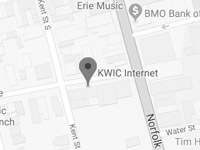Does your Wi-Fi tend to be less reliable during stormy days? The truth is, lousy weather can result in connection issues which can be frustrating when you’re trying to get work done or enjoy an evening with your favourite device. But there could be other issues to blame that aren’t weather-related at all.
Let’s be the silver lining to those storm clouds brewing in the wintry months ahead! To help you improve your connection, here is the lowdown on how bad weather can affect your internet connectivity and how to better prepare so you can stay connected.
Three Ways the Weather can Impact Your Internet
Rain
Light rain won’t have much of an effect on your internet connection, but heavy downpours could. This is one of the most common weather events that causes disruptions to the service since it can physically damage cables, especially if your network relies on older infrastructure.
Extreme Weather Events
Of course, extreme weather can definitely result in outages and internet issues, especially when there are high winds. Blizzards, ice storms, severe wind gusts and flooding can cause infrastructures to fail, trees to fall on to power lines, and floodwaters to impact electrical systems, which can lead to widespread damage and outages.
Temperatures
Extreme heat could cause equipment to overheat and slow down. When it comes to cold temperatures, fiber optic cables are more resilient and can usually withstand those severe dips. Overall, temperature has shown to have little effect on internet speeds. If anything, it may function slightly slower than normal.
Bad Weather can Actually Increase Internet Use
In many cases, when your Wi-Fi lags during messy weather, Mother Nature isn’t to blame at all. In fact, most of the time, it’s due to an increase in internet traffic. When it’s raining, snowing or freezing outside, we are all less likely to go outside. Instead, we tend to stay comfy and safe at home, curled up with our devices, either streaming or surfing. As a result, bandwidth gets a little choked and sometimes services slow down, especially if you don’t have the right service active for your household’s use cases and size.
What to Do During a Storm
Reboot Your Router
You can do this by simply switching your modem off, unplugging it, and waiting a minute or two. Then plug it back in and turn it on again. Give it a few moments to see if that made a difference. Make sure you stay away from the button that factory resets your router. If you press that button, you might have no internet at all!
Move Closer to the Router
If you’re located too far from your router, your connection may be slower. Try to move closer to it to see if that improves your internet connection.
Check Multiple Devices
If you’re having a connection issue with your laptop, for example,, check your phone to see if it’s a network issue or something wrong with your device.
What Not to Do During a Storm
Don’t Try to Do Anything Elaborate to Fix it
If all of the above steps don’t do the trick, don’t try to mess with your setup and fix it. This often leads to more problems. Instead, contact your provider and get assistance from an experienced technician. We’re happy to help at any time with our support services!
Don’t Go Out to Inspect the Weather or Damaged Power Lines
You may be tempted to step outside during messy weather just to see what’s happening. This can be extremely dangerous, depending on the circumstances. Avoid going out until the bad weather has passed. If you notice any issues once it has cleared, such as downed power lines or an inactive internet connection, contact the appropriate provider of the service for a technician to come out and inspect it. If your area has a power outage, report it to your electric company.
Storms are unpredictable and can cause major headaches, but you can get internet services that are dependable and stable enough to keep you connected anytime. Stop struggling with poor connectivity and switch to KWIC. We are a full-range internet service provider, delivering high-speed internet throughout Ontario. Contact us today to learn more or to sign up!
